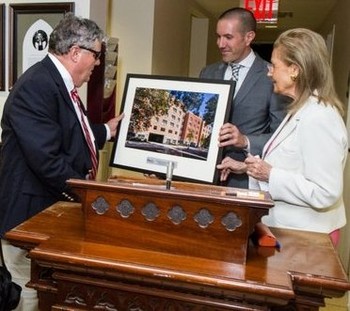“To everything there is a season, and a time to every purpose under Heaven.”
If you were to ask the Rev. Don Olinger, retired pastor of the Presbyterian Church of Astoria, he’d be apt to endorse the opening line of Ecclesiastes 3.
But, being the persuasive, passionate person that he is, he’d be most likely to heavily advocate that the conclusion of this verse be tweaked to read, “And a time for every (re)purpose under heaven.”
On Sept. 16, a warm Monday evening in the last week of summer here in the New York City Borough of Queens, community and religious leaders joined with civic officials, a member of Congress and a couple of dozen “regular folks,” shoe-horning themselves into the lobby of the recently-opened HANAC-PCA Senior Residence.
They all gathered at the invitation of Evangeline Douris, chair of the Hellenic American Action Committee [HANAC] to honor the vision of Olinger and the members of the Presbyterian Church of Astoria [the “PCA” portion of HANAC-PCA.]
Also honored was the memory of the stone church, church house and manse which used to stand on this site, now re-purposed as a new, six-story building with 66 studio and one-bedroom apartments, home to 65 seniors plus a live-in superintendent. The facility also includes a parking garage, office space for the senior services staff and indoor and outdoor recreational spaces ― including a garden with a full-size bocce court!
Much of the new lobby’s furnishings are repurposed from Astoria Presbyterian, making it easy to understand why this evening’s tribute prompted thoughts of Ecclesiastes to this observer. The rich brown wainscoting once adorned the chancel and choir benches. The ornately-carved, two-tiered pulpit has been spiffed-up and now serves proudly as a lectern for guest speakers.
On the walls, what were once hymn boards now hang lovingly as folk art, while original artifacts from the congregation’s history ― many discovered when a lead box turned up during demolition was later pried open to reveal a century-old time capsule ― are displayed in custom made cases that echo the interior arches of the former church building.
While not a specifically a Presbyterian “owned” project, the PC(USA) seal is showcased on one wall captioned by a loving embrace of the cooperative nature of the project.
This September evening’s festivities are rooted in a confluence of events which occurred around the turn of the 21st Century. At that time, Astoria Presbyterian, nestled on a cozy side street a mere 15 minutes by subway from the hustle and bustle of Times Square, was forced to face a not-so-warm-and-fuzzy reality: Olinger’s failing eyesight from Stargardt’s disease, the congregation’s diminishing membership, and the mounting expenses and frustrations incumbent with the property’s three rapidly-aging 1920s-era buildings which had replaced the original 1846 Colonial Revival church structure.
Astoria Presbyterian began a time of discernment, discussion and prayer. The congregation examined several approaches, ranging from a total dissolution and sale ― in essence, folding the tent and walking away from some 160 years of service ― to finding “financial angels” willing to help underwrite the renovation and modernization of their creaking structures.
Olinger championed the sentiment that a church is not a building but the people inside the building. Despite his dimming vision, he continued to see a bright future for his congregation even if it didn’t include Astoria’s fading shell.
By 2005, the congregation had reached “A time to cast away stones,” agreeing on a plan to sell the buildings and grounds to a not-for-profit organization which “exemplified the congregation’s mission of ‘helping people.’” Then, using the sale price ― some of which would go to fund their endowment ― Astoria Presbyterian would remain alive, albeit serving God and Astoria from a different location in their familiar neighborhood.
Not every Astoria member got on board with the repurposing plan. Some left while others decried it as “…a time to die.” Ultimately, their “Save Astoria Presbyterian Church” as-is movement fell short.
Contract talks began that fall with the nonprofit Enterprise Community Partners and with HANAC. Enterprise would finance the project of low-rent housing for the elderly which HANAC would build using funds provided largely through tax credits and by the federal government.
Standing with Astoria was the Presbytery of New York City, which turned out to be a fount of sage advice on the often-maddening world of New York City building regulation issues, especially within the nonprofit world.
The project snaked its way through the Presbytery of New York City and through the civil entities ― New York State statutes require specific steps for the dissolution of religious property ― at what often seemed like mind-numbingly slow pace.
Then, a not-so-funny thing happened on the way to the new iteration: the economic downturn.
For a project that already endured and survived tears, invectives, prayers, protests, a touch of intramural ecclesiastical wrangling plus the potential monkey wrench of secular political intrigue over whether or not a proposed chapel conflicted with the separation of church and state issues regarding the potential tax credits and HUD financing, the economic cliffhanger did not break the proverbial camel’s back.
After seemingly endless weeks/days/hours of gut-wrenching waiting, good things did come to those who waited.
By late-summer 2008, the project was an active construction site. The HANAC-PCA Senior Residence was move-in ready by late-fall of 2012, almost as if this was what the author of Ecclesiastes had in mind when he wrote Verse 22: “…there is nothing better, than that a man should rejoice in his own works; for that is his portion: for who shall bring him to see what shall be after him?”
To watch a video produced by the Presbyterian Foundation -- another key partner in the re-purposing of the Presbyterian Church of Astoria -- visit https://vimeo.com/channels/570106/65035386.
Jim Nedelka, a ruling elder at New York’s Jan Hus Presbyterian Church & Neighborhood House, has been contributing to the Presbyterian News Service since 2007.

